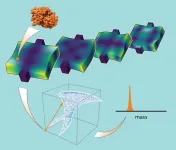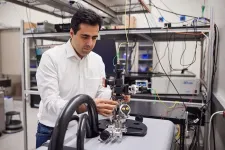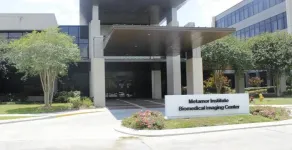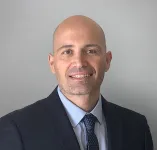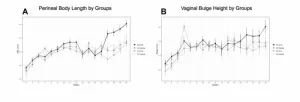(Press-News.org) Caltech scientists have developed a method driven by machine learning that allows them to accurately measure the mass of individual particles and molecules using complex nanoscale devices. The new technique opens the possibility of using a variety of devices for the measurement of mass and, therefore, the identification of proteins, and could pave the way to determining the sequence of the complete proteome, the collection of all the proteins in an organism.
Proteins are the engines of living systems. Which proteins are made, where, and in what amounts can provide important information about the health of systems, clues as to what happens in the case of disease, and potential approaches to fighting disease. But scientists do not yet have a way of characterizing entire proteomes.
"We're now talking about mass spectrometry at the single molecule level; the ability to look at entire proteins in real time without chopping them up," says Michael Roukes, the Frank J. Roshek Professor of Physics, Applied Physics, and Bioengineering and an author of a paper in the journal Nature Communications that describes the new technique. "If we have a single-molecule technique that has high enough throughput so we can measure millions of proteins within a reasonable time, then we can actually understand the complete proteome of organisms, including humans."
Mass spectrometry is a common analytical tool scientists use to accomplish all sorts of molecular sleuthing. Start with a mysterious sample, ionize it (i.e., give it a charge by removing one or more electrons), and send it speeding along a specified path. Then use a magnetic or electric field to give the ions a shove from the side and see how far they move. The lighter and more positively charged the ions, the more they will get deflected; this provides a way to measure the mass and charge of each of the various ions present. With that information, researchers can try to solve for the sample's chemical makeup.
Mass spectrometry is used for many purposes, including the analysis of trace elements in forensics, detection of disease biomarkers, and analysis of pesticide residues. But the initial ionization step is not ideal for all samples, especially biological samples that can be altered by the process.
Things get more complicated when samples become minuscule—for example, when scientists want to determine the mass of an individual protein. Over the past two decades, with the development of sophisticated nanoscale devices called nanoelectromechanical systems (NEMS), it has become possible to perform a type of mass spectrometry that does not require a sample to first be ionized. This has led to routine measurements of the masses of small molecules in real time. With this approach, scientists do not have to make best guesses when interpreting which chemical species are most likely to be found in a sample. But the method has ruled out certain complex NEMS devices from being used for mass spectrometry.
NEMS mass spectrometry is typically accomplished with a silicon device that you can think of as a tiny beam tethered on either end. When the beam is struck, it resonates like a guitar string and moves up and down with certain mode shapes occurring at different frequencies.
If a sample is placed on such a beam, the individual frequencies of the beam's vibrational modes will change. "From these frequency changes, you can infer the mass of the sample," says John Sader, a Caltech research professor of aerospace and applied physics and lead author of the new paper. "But to do that, you need to know the shape of each mode. That's at the core of all these measurements currently—you need to know how these devices vibrate."
With the newest NEMS devices, it is not always possible to determine a precise mode shape. That is because, at the nanoscale, there are device-to-device variations or imperfections that can slightly change the mode shapes. And the advanced NEMS devices that researchers have developed to study the fundamental physics of the quantum realm have extremely complicated three-dimensional modes whose frequencies are very close to each other. "You can't just simply calculate the mode shapes and their frequencies using theory and assume these hold during a measurement," Sader says.
A further complication is that the precise location at which a sample is dropped within a device affects the frequency measurements of the beam. Thinking again of that simple beam device, if the sample is placed close to one of the tethered ends, the frequency will not change as much as if it were placed near the center, for example, where the vibrational amplitude is likely to be greater. But with devices roughly a single micron by a single micron in size, it is not possible to visualize the exact placement of a sample.
Fingerprints Indicate Location and Lead to Mass
Sader, Roukes, and their colleagues have developed a new technique they call "fingerprint nanoelectromechanical mass spectrometry," which bypasses these problems.
Following this method, the researchers randomly place a single particle on the NEMS device under ultrahigh vacuum and at ultralow temperature. In real time, they measure how the frequencies of several device modes change with that placement. This allows them to construct a high-dimensional vector representing those changes in frequency, with one vector dimension for each mode. By doing this repeatedly for particles placed in a variety of random locations, they built a library of vectors for the device that is used to train the machine-learning software.
It turns out that each vector is something of a fingerprint. It has an identifying shape—or direction—that changes uniquely depending on where a particle lands.
"If I take a particle with an unknown mass and place it anywhere on the NEMS device—I don't know where it has landed; in fact, I don't really care—and measure the frequencies of the vibrational modes, it will give me a vector that points in a specific direction," Sader explains. "If I then compare it to all the vectors in the database and find the one which is most parallel to it, that comparison will give me the unknown particle mass. It's simply the magnitude ratio of the two vectors."
Roukes and Sader say that this fingerprint technique can work with any device. The Caltech team theoretically analyzed phononic crystal NEMS devices developed in the lab of their colleague, Stanford physicist Amir Safavi-Naeni, for this study. These advanced NEMS devices effectively trap vibrations so that at certain frequencies they continue to "ring" for a long while, giving researchers plenty of time to gather quality measurements. The fingerprint method enables mass spectrometry measurements with these state-of-the-art devices. In preparation, the team used alternate devices to benchmark their fingerprint method. This included measuring the mass of individual particles of GroEL, a molecular chaperone protein that helps with proper protein folding in the cell.
Roukes notes that for large protein complexes and membrane proteins such as GroEL, standard methods of mass spectrometry are problematic for several reasons. First, those methods provide the total mass and charge, and those measurements do not uniquely identify a single species. For such large complexes, there would be many possible candidates. "You need to disambiguate that in some way," Roukes says. "The preeminent method of disambiguation at this point is taking the puzzle and chopping it up into fragments that are between 3 and 20 amino acids long." Then, he says, you would use pattern recognition to identify the mother molecule from all the daughter fragments. "But you no longer have a unique identifier of what the configuration or conformation of the original thing was because you destroyed it in the process of chopping it up."
The new fingerprint technique, Roukes notes, "is heading toward an alternative called native single-molecule mass spectrometry, where you look at large proteins and protein complexes, one-by-one, in their native form without chopping them up."
The paper, "Data-driven fingerprint nanoelectromechanical mass spectrometry" appears in the October 22 issue of the journal Nature Communications. Additional authors of the paper are Alfredo Gomez, a graduate student at Carnegie Mellon University who was a Schmidt Academy for Software Engineering Scholar at Caltech during this project; Adam P. Neumann (PhD '20), a former graduate student in Roukes's lab at Caltech; and Alex Nunn, a graduate student in applied physics at Caltech who completed the work as a junior computational scientist at the Institute. The work is supported by the Wellcome Leap Foundation through its Delta Tissue program.
END
Caltech's new fingerprint mass spectrometry method paves the way to solving the proteome
The new data-driven technique gives scientists a way to accurately measure the mass of individual proteins using nanoscale devices
2024-10-22
ELSE PRESS RELEASES FROM THIS DATE:
Invasive flathead catfish impacting Susquehanna’s food chain, researchers find
2024-10-22
UNIVERSITY PARK, Pa. — Flathead catfish — native to the Mississippi River basin — were first detected in the Susquehanna River in Pennsylvania in 2002, according to the U.S. Geological Survey. In the two decades since then, the invasive species has spread throughout the river basin. The impact of the large predator on the waterway’s food webs and ecology was unknown, but now a research team is beginning to understand what Susquehanna flatheads are eating and how their presence is affecting native aquatic species in the river.
The findings, which the team said state ...
Javadi receives DOE Early Career Award to study qubit hosts
2024-10-22
NORMAN, OKLA. – Alisa Javadi, Ph.D., professor at the University of Oklahoma School of Electrical and Computer Engineering and the Homer L. Dodge Department of Physics and Astronomy, has received funding from the U.S. Department of Energy Early Career Research Program for research that offers the potential for advancing quantum technology development.
Javadi’s research will test the use of cerium oxide as a host for quantum bits, or qubits. Qubits, the building blocks of quantum computing, need an environment free ...
Obesity Medicine Fellowship created at Pennington Biomedical
2024-10-22
Obesity Medicine Fellowship Created at Pennington Biomedical
Fellowship product of collaboration between Pennington Biomedical Research Center’s Metamor Clinic and Louisiana State University Health New Orleans School of Medicine
FOR IMMEDIATE RELEASE
Oct. 22, 2024
BATON ROUGE – A new Obesity Medicine Fellowship at Pennington Biomedical Research Center is now open for candidate applications. The one-year program is the result of a collaboration between Pennington Biomedical and Louisiana State University Health ...
Structural biology analysis of a Pseudomonas bacterial virus reveals a genome ejection motor
2024-10-22
BIRMINGHAM, Ala. – The viruses that infect bacteria are the most abundant biological entities on the planet. For example, a recent simple study of 92 showerheads and 36 toothbrushes from American bathrooms found more than 600 types of bacterial viruses, commonly called bacteriophages or phages. A teaspoon of coastal seawater has about 50 million phages.
While largely unnoticed, phages do not harm humans. On the contrary, these viruses are gaining increasing popularity as biomedicines to eradicate pathogenic ...
Remote tool developed to helped detect autism and developmental delay in children with limited access to specialists
2024-10-22
A Ukrainian researcher has developed a new digital tool for detecting autism and developmental delay in children. Her research has been published in Cambridge University Press journal Cambridge Prisms: Global Mental Health.
The tool incorporates the basic principles of the Kids’ Development Diagnosis and Determining the Risk of Autism (KiDD) methodology, for children aged 1.5 to 6 years old, into mobile app form. It has the potential to help diagnose children more swiftly and efficiently, which could have major positive ...
Texas Accounting Chair Steven Kachelmeier garners coveted award for scholarship
2024-10-22
Texas Accounting Chair Steven Kachelmeier Garners Coveted Award for Scholarship
AUSTIN, Texas — The American Accounting Association (AAA) presented its Lifetime Achievement Award for Behavioral Accounting Research to Steven Kachelmeier, a professor and chair of the Department of Accounting at The University of Texas McCombs School of Business. Kachelmeier, the Thomas O. Hicks Endowed Chair in Business, accepted this prestigious award during the weekend at the association’s 2024 Accounting ...
CABHI launches funding program that ignites innovation to advance healthy aging
2024-10-22
TORONTO, Oct. 22, 2024 – Today, the Centre for Aging + Brain Health Innovation (CABHI), powered by Baycrest launched Ignite, its new funding program to support Canadian innovators designing solutions for older persons. As Canada’s aging population rapidly grows – with nearly 20 per cent of people above the age of 65 – so too will the need for innovations that enhance the lives of older persons, including those impacted by dementia.
Canadian early-stage innovators – including researchers, point-of-care staff, and companies – are developing ...
A fully automated AI-based system for assessing IVF embryo quality
2024-10-22
A new artificial intelligence-based system can accurately assess the chromosomal status of in vitro-fertilized (IVF) embryos using only time-lapse video images of the embryos and maternal age, according to a study from investigators at Weill Cornell Medicine.
The new system, called "BELA,” and described in a paper published Sept. 5 in Nature Communications, is the team’s latest AI-based platform for assessing whether an embryo has a normal (euploid) or abnormal (aneuploid) number of chromosomes—a key determinant of IVF success. Unlike prior AI-based approaches, BELA does not need to consider embryologists' subjective assessments of embryos. ...
Senolytics dasatinib and quercetin for prevention of pelvic organ prolapse in mice
2024-10-22
“This study represents one of the first to evaluate the impact of senolytic agents D+Q on the clinical development of pelvic organ prolapse and expression of proteins associated with cellular senescence in a mouse model.”
BUFFALO, NY- October 22, 2024 – A new research paper was published in Aging (listed by MEDLINE/PubMed as "Aging (Albany NY)" and "Aging-US" by Web of Science), Volume 16, Issue 19 on September 26, 2024, entitled, “Use of the senolytics dasatinib and quercetin for prevention of pelvic organ prolapse in a mouse animal model.”
Pelvic organ prolapse is a common condition among women ...
UCLA efforts to provide prostate cancer treatment in the community gets $6 million boost
2024-10-22
The UCLA Urology department has been awarded $6 million from the California Department of Health Care Services to continue providing vital care and critical services to underinsured and uninsured Californians diagnosed with prostate cancer.
For the next two years, the additional funding will support the 23-year-old IMPACT program—which stands for Improving Access, Counseling, and Treatment for Californians with Prostate Cancer—and extend the program’s reach and duration, ensuring continued support for California’s most vulnerable populations.
Led ...
LAST 30 PRESS RELEASES:
School meals could unlock major gains for human and planetary health
Menopause hormone therapy does not appear to impact dementia risk
Signature patterns of brain activity may help predict recovery from traumatic brain injury
Dresden study uncovers new key mechanism in cancer cells
New species are now being discovered faster than ever before, study suggests
Cannabis-based products show limited short-term benefit for chronic pain, with increased risk of adverse effects
Cannabis products with more THC slightly reduce pain but cause more side effects
Clearing the brain of aging cells could aid epilepsy and reduce seizures
Brain injuries linked with potential risk of suicide, new study finds
New technique lights up where drugs go in the body, cell by cell
New study finds movement of fishing fleets can reveal shifts in marine ecosystems
Embargoed: New evidence points to potential treatment for vascular dementia
Study uncovers disrupted brain balance in alcohol dependence
Working in groups can help Republicans and Democrats agree on controversial content moderation online
Structural findings reveal how distinct GPCR ligands create different levels of activation
Anything-goes “anyons” may be at the root of surprising quantum experiments
UC review: Maximizing workplace opportunity for veterans
From generation to complex control: Metasurfaces make perfect vortex beams "within reach"
Thin-film lithium niobate-based detector: recent advances and perspectives
Exploring why some people may tend to persistently make bad choices
How cells balance their protein levels
Nirsevimab vs RSVpreF vaccine for RSV–related hospitalization in newborns
Effectiveness and impact of maternal RSV immunization and nirsevimab on medically attended RSV in US children
AI gives scientists a boost, but at the cost of too many mediocre papers
Next-generation vision model maps tree growth at sub-meter precision
Genes aren’t destiny for inherited blindness, study shows
MIT study: High-fat diets make liver cells more likely to become cancerous
Exposure to multiple fine particulate matter components and incident depression in the US Medicare population
Risk of burdensome health care spending over time in the US
Nirsevimab against hospitalizations and emergency department visits for lower respiratory tract infection in infants
[Press-News.org] Caltech's new fingerprint mass spectrometry method paves the way to solving the proteomeThe new data-driven technique gives scientists a way to accurately measure the mass of individual proteins using nanoscale devices
